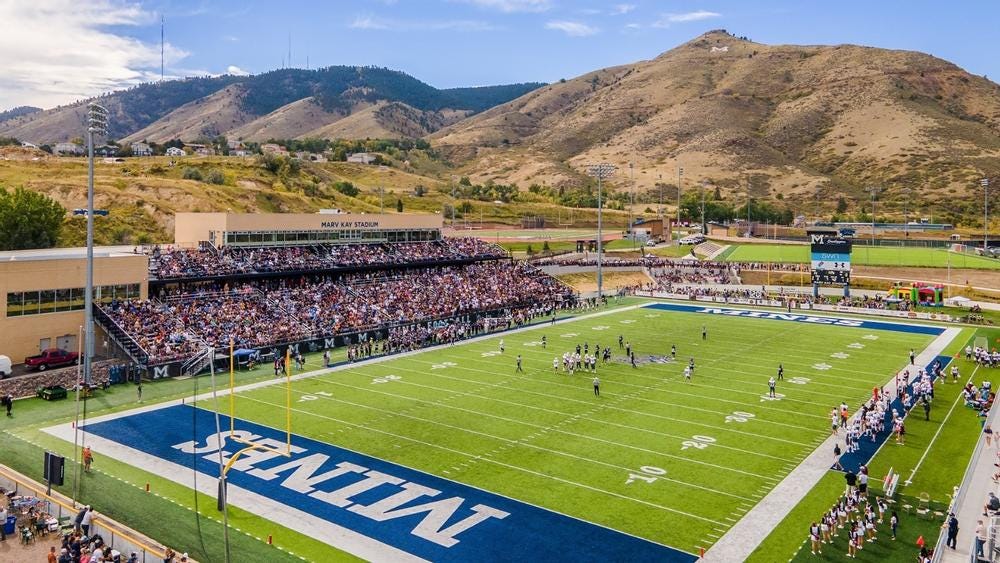Colorado School of Mines' long football climb is nearly complete
The improbable Division II football power in the foothills of the Rockies is on the verge of its first-ever national title
Hey everyone. I wanted to take a moment here to note that this will be the only newsletter this week. My wife and I — along with our eight month old and our two dogs — are beginning the two-day trek by car from Denver back to Kentucky for the holidays. Between that and moving into a new place earlier this month, my schedule got a little more hectic than it usually is. Next week, though, we’ll be back to two posts a week.
I appreciate the understanding and, as always, appreciate everyone for subscribing and reading along. I truly can’t express how much it means.
On to this week’s newsletter…
There’s a tradition at the Colorado School of Mines that goes back 115 years.
As part of what’s known as the M Climb, every incoming student at the Golden, Colo. university brings a 10-pound rock from their hometown and carries it up Mt. Zion, a 7,062-foot mountain a couple of miles southwest of the school’s campus. Once they reach the top of the 1,400-foot uphill trek – remember, it’s Colorado, with Golden at just shy of 5,700 feet above sea level – they place the rock among all the others that form a giant ‘M’ that, once it is whitewashed, is visible from miles away.
For students, it’s a bonding experience, an effective (albeit physically taxing) way to get immersed in the culture and camaraderie of this new place where you’re spending those wonderful and oft-mythologized next several years of your life. If you want to read deeply enough into it, there’s surely a metaphor to be found about perseverance and sticktoitiveness, a lesson that will undoubtedly come in handy at a school in which the overwhelming majority of students are engineering majors.
It applies just as aptly, though, to a football program that plays in the shadow of that cherished ‘M.’
On Saturday, Mines’ football team, the top-ranked squad at the Division II level, will compete in the national championship game in McKinney, Texas against Harding. If the Orediggers are able to cap off an undefeated season with a 15th and final win, it will be their first ever title. Even if they don’t pull that off, they’ve accomplished a great deal this season, with a school-record 14-game win streak, one of the sport’s top offenses and a quarterback who just might win Division II football’s highest individual honor for the second year in a row.
The fact they’ve gotten so close to the summit isn’t a surprise. After all, they were at this point this time last year – they were blown out in that title game by Ferris State, 41-14 – and are making their fifth-consecutive playoff appearance.
But how they’ve reached this point isn’t too dissimilar from how a bunch of 10-pound boulders make it up a mountain to form a giant letter. It’s a lot of hard work over a long period of time that has culminated in something that’s not only beautiful, but quite memorable, too.
Mines has not only created a winner where one didn’t previously exist at a small engineering school tucked in the foothills of suburban Denver, but it has done so in its own, undeniably distinct way.
How did Mines get to this point? Stitt happens
It wasn’t always this way at Mines. Far from it, actually.
From 1929-99, the Orediggers had just 10 winning seasons, going a paltry 173-311-14 over that stretch. It wasn’t just that they weren’t competitive, but it didn’t seem as though they were even trying to be, even if that lack of effort was for ostensibly well-intentioned reasons.
When Bob Stitt arrived as Mines’ coach after the 1999 season, he encountered what was an adversarial relationship between athletics and academics at the school. As he described it to the Denver Post last year, the Orediggers had “zero support.”
“The attitude was, ‘Oh, well, we’re just here for school and football doesn’t matter,’” Stitt said. “I got a lot of pushback from people at the school and alums (at the time) and things like: ‘They’re not here to play football, they’re here to get an engineering degree.’”
Stitt knew the two sides could co-exist, having arrived in Golden after a year as the offensive coordinator at Harvard, which had gone 9-1 two seasons before his hiring and 9-0 two seasons after his departure at a school that, whatever you may think about it, has a certain academic pedigree.
Stitt, however, was able to offer Mines something more than just a previous pitstop at an Ivy League school.
Keep reading with a 7-day free trial
Subscribe to The Front Porch to keep reading this post and get 7 days of free access to the full post archives.




